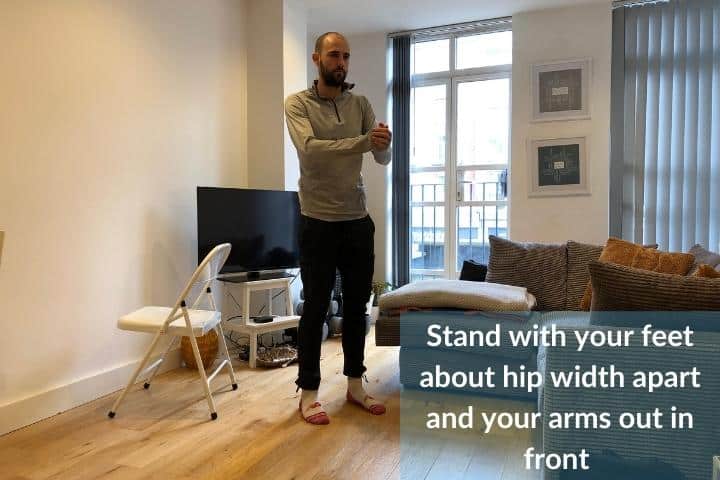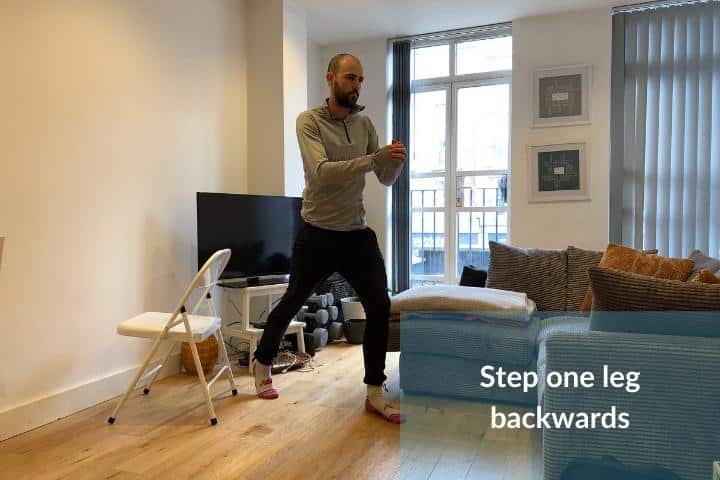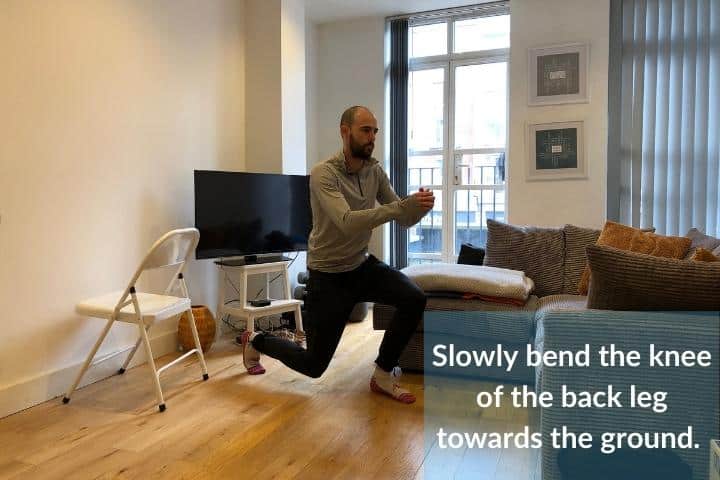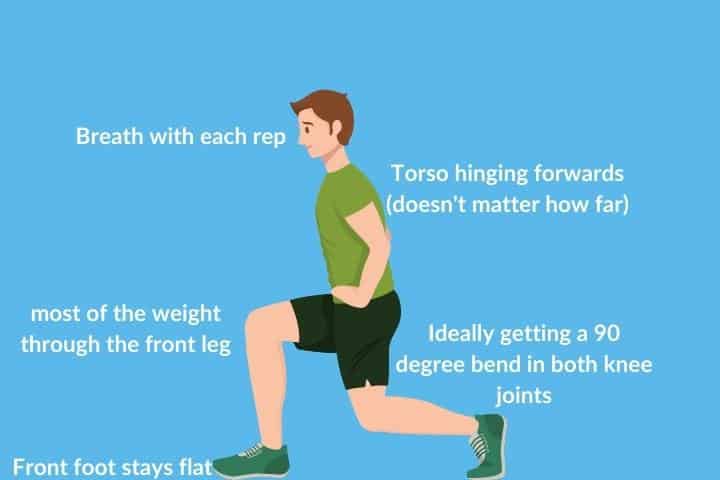In this article I'll demonstrate the best way to do reverse lunges for seniors. I'll also include lots of variations for those with limited strength and mobility
Last updated January 2023
This article contains a lot of evidence based information on lunges for seniors. I recommend using the contents table above to find the specific information about lunges you are looking for.
Let's kick things off by watching this amazing video I recorded in my home studio flat here in London, UK.
A video is by far the best way to show you and explain to you how to do great lunges.
Note: Technically these are reverse lunges as you step backwards instead of forwards. Reverse lunges are much easier to do 🙂
(if you can't see the video click HERE to view on youtube
I've also included these great visuals on how to set up and execute the lunge perfectly.
Step 1:
Step 2:
Step 3:
What makes lunges such a good exercise for seniors and older adults?
Just like the squat the lunge is a compound movement meaning 2 or more major muscle groups are being worked during the exercise.
In the case of the lunge the quads, glutes and hamstrings are being worked.
When the torso is kept more upright during the movement most of the tension will be in the quad (front of the upper leg). If the torso hinges forward more during the movement the tension is shifted more into the glutes and hamstrings (back of the upper leg)
The lunge is also a unilateral movement as you are working 1 limb at a time. A unilateral movement can be really helpful in helping even out muscle imbalances between different limbs.
What are some common mistakes that older adults commonly make when doing the lunge?
One the biggest mistakes I see during the lunge movement is when the heel of the front foot comes of the ground. As I mention in the video, the front foot should remain flat all the way through the movement.
In fact the front leg should be taking about 80% or more of the weight distribution. The back leg is more of a support.
It's also a good idea to keep the feet hip width apart all the way through the movement. This will allow for a lot more balance.
Another issue I commonly see is people not holding onto something for support. It's absolutely fine to do this and I actually encourage it. Just having a light hold of an object such as chair can help with the balance so that you can really concentrate on push through that front leg.
How reps and sets of lunges should I do as an older adult?
How many reps of lunges you do will depend on many factors.
What you need to know is that in order for your body to adapt and become stronger there are a few "must do" things you have to do. The following 3 things are the cornerstones of a successful strength building programme.
- Volume - How many sets and reps you per week
- Frequency - How many times you train per week
- Intensity - How hard to push during each set and overall session.
Combining these 3 things along with appropriate exercises is known as programming. Effective programming is vital in order for progress to be made.
Just randomly throwing a few lunges into your routine here and there won't do anything.
The best thing to do is join the Wise Fitness Academy which provides monthly workouts as part of a structured programme that will illicit great results.
It hurts when I do lunges, what should I do?
Generally speaking you should avoid an exercise if it causes you pain.
Everyone is very different and certain exercises will suit some people and not others.
You could try changing the movement a little bit such as taking a bigger or smaller step backwards. Or you could try stepping forwards in stead of backwards. You could reduce the range of motion. You could use more support and allow your upper body strength to assist with the movement.
Small or subtle changes will often result in you being able to perform the exercise much more comfortably.
Sometimes however, we have to accept that a certain exercise might just not suit us.
In this event, just stop doing it all together. There are always alternative exercises that you can do instead. I always provide alternative exercises as part of the Wise Fitness Academy monthly workouts.
I have arthritis, can I still do lunges?
The the answer to this question is individualised. This review looked at knee osteoarthritis. It highlights the importance of resistance training on helping to manage arthritis and reduce pain and discomfort that arthritis causes.
Some pain is to be expected in those with arthritis but it should only be moderate and shouldn't extend beyond the exercise session. If the pain during the exercise gets progressively worse or it causes limping then the amount of resistance should be reduced or the exercise stopped all together.
Individual severity of osteoarthritis needs to be considered but the research does clearly show that even those with severe osteoarthritis can successfully participate in a resistance training programme.
Everyone should do a brief warm up before exercising but arthritis sufferers can try these 7 specific exercises that the arthritis.org recommends.
It might be that choosing to avoid lunges is the best option for you and instead pick less high impact options.
We have a huge array if different low impact exercise within the Wise Fitness Academy that help to build strength and muscle whilst limiting the amount of pressure and impact on the joint.
Do I need to warm up before I do lunges?
Yes, lunges should be a part of your main exercise which is done after you have warmed up.
Warming up just requires a gentle raising of the heart rate and gentle movements to warm the muscles up.
I do often prescribe partial lunges as part of a warm up. A partial lunge is when you only take the joint through a small range of motion. You can see an example of the partial lunge in the video at the top of this article.
Take a look at the warm up I do in this 20 minute workout for Wise Fitness Academy members.
Conclusion
Lunges are a fantastic compound exercise that definitely should be part of your regular workout routine. If lunges do cause you a lot of pain and the pain doesn't seem to get any better over time then lunges can be replaced with other exercises instead.





